Sound:
This is my first product from Matrix Audio, and thus I don’t have any experience with what their other gear sounds like. But even when coming in with a tabula rasa like this, it’s always great to find out the little details about new gear. I have heard many implementations of the ESS chips though, and there seems to be a general consensus that they sound very detailed and a notch brighter. Not every ESS loaded product does feature that though, just think of the Cowon Plenue L.
I like being positively surprised. I mean, who doesn’t? The Element M definitely was a nice surprise. So let’s find out why.
The Element M has a very nice controlled and neutral response. It features a rich and impressively detailed sound, that brings out the finest of beeps. It’s an accurate sound, that doesn’t fail to impress with a natural approach. Yes, there is a typical Sabre shimmer, but I wouldn’t call it analytical, as it delivers a slight touch of warm air in the entire frequency response.
Bass reaches deep into the sub-bass areas with good resolution and rumble. There is plenty of foundation down low, which gives the entire scene a solid ground. Bass has a nicely full body, with very good texture and layering. Speed-wise lows are neither too slow and relaxed, nor too fast and unrealistic. You get a well controlled low end, with good punch, drive and authority. Although bass isn’t overly forward or prominent in the picture, it delivers good harmonic warmth into the lower midrange.
The lower mids have excellent weight in them, which makes deep male vocals sound vibrant and robust. There is some slight warmth in the midrange, which gives the picture a nice colouration to sound a bit more natural. Instruments sound realistic and life-like, with good body, texture, size and weight. Vocals, both male and female, transport an emotional character, which makes them convincing to me.
I really like the richness-level the Element M possesses. Every note that makes it through sounds just gorgeous. You don’t get much grain or sharpness with the Element M in the notes. And this makes it a real pleasure to listen to.
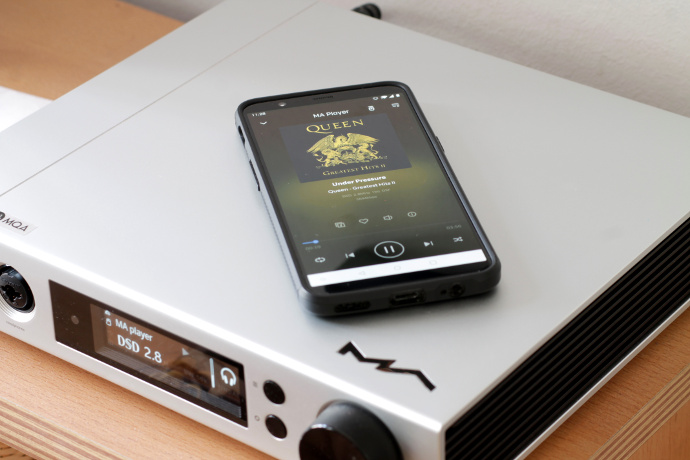
Matrix Audio Element M
On a technical point of view, the Element M is a solid performer as well. It creates a very nicely spread sound stage, with absolutely perfect layering. The stage stretches wide and deep in almost even measures. You get a very precise sound, that has high resolution and very accurate rendering. Musicians are well separated with good air surrounding them. Imaging is spot-on, although there is room for improvement in terms of how clean the instruments are to be distinguished. The background is almost pitch black as well. Which is always a good thing.
Treble is detailed, energetic and fast, just as we know it from other Sabre DACs. But unlike most of them, the Element M comes with a clean and rich sounding top end. It has superb extension into the upper registers and provides good air. The Element M has a revealing treble, that brings out very fine micro details with ease. I’m a person that can take a good dose of highs, but with the Element M I am never pushed to my limits. It’s not sibilant, it’s not sharp and it definitely isn’t hard-edged. It’s an easy going treble for me.
Pairings:
A vital part of enjoying our hobby is finding a good synergy with what we already have at home. The 1,320 mW power should be good enough for a wide range of headphones. We’ll check out how the Element M handles hard to drive headphones and even an earphone.
HiFiMAN – HE1000se (96dB/mW; 35 Ohms)
The HE1000se is a fairly easy to drive headphone. I am comfortable at -30dB, so there is more than enough room left to play.
With the HE1000se you get a nicely balanced sound, that comes in with a smooth and neutral signature. There is very good body and texture from top to bottom. The HEKse is a splendid performer in terms of resolution, layering and imaging. With the Element M in the chain you get a sound that’s goes high on information. It stretches a very nice sound stage with wonderful imaging and separation.
Bass is tight, fast and full with a very nice vibrant and physical touch. The HE1000se reaches very deep with superb grunt and resolution. It layers wonderfully and manages to stay in control at all times. You get a dynamic and fun sounding low end, that will make you tap your toes to the beat. Midrange is smooth and organic, with plenty of body and resolution. You get very good weight in each instrument and singer. Vocals sound emotional and just very convincing. Male singers sound full, dense and physical, while females are rich and emotional. There truly is no blemish in the midrange. Treble is detailed, clear and energetic. The HE1000se does not have the most forward sounding treble, and that matches really well with the Sabre shimmer of the Element M.
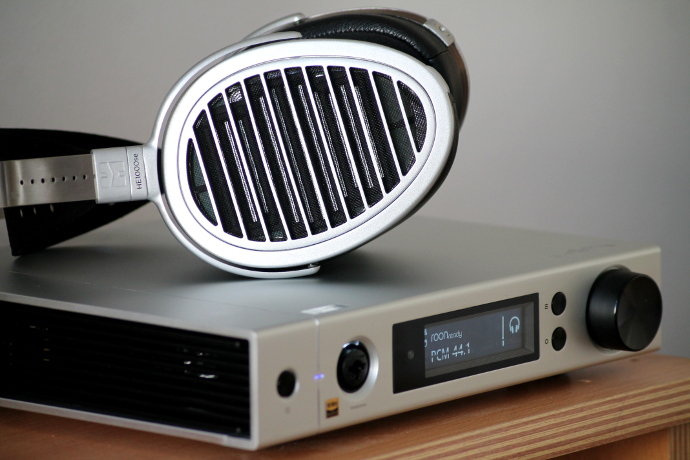
Matrix Audio Element M
HiFiMAN – Susvara (83dB/mW; 60 Ohms)
The Susvara is probably the hardest to drive headphone in today’s market. I don’t know many other models that require the power the Susvara demands. Maybe the AB-1266 Phi TC from Abyss is similarly hard to drive, but I don’t have that one here. I know the original AB-1266 was a beast to drive. With the Susvara I need to reach comfort levels at -5dB. There is still some room left to go higher on the volume knob, should you want to reach bleeding levels.
With the Susvara you get a fast and precise sound, that does not overlook musicality and harmony in the signature. The HiFiMAN is certainly one of my absolute favourites and it is here to stay. You get a finely rendered picture, with superb precision and resolution. There’s not a single tone that won’t be uncovered by this combination, as it tickles out everything. You get a wide, deep and tall stage with a three-dimensional sound that wraps around you. It truly is a remarkable combination between the Matrix and the HiFiMAN.
Bass is fast, deep, dynamic and full. It reaches deep into lows with just perfect control. Staying still will be hard with this energetic sound. Mids have excellent body and weight, for a very natural sound. You get very good transparency and layering with the Susvara Element M combo. You get a nice harmonic sound, that is filled with emotions and blood. Vocals convince with superb presentation. They are just the right size and weight, where they don’t sound congested or closed in. Anything but that would not be accepted for a headphone in this region though. Treble is agile, crisp and rich, it’s sharp without ever being sibilant or harsh.
Abyss – Diana Phi (91dB/mW; 32 Ohms)
The Diana Phi is a relatively inadequate to drive headphone. Although definitely easier to drive than the Susvara, the Diana Phi also requires some power to come out and play. The I reach comfort levels with the Diana Phi around -17dB on the volume scale.
With the Phi you get an immensely detailed, fast and accurate sound. It’s precision above all. Bass reaches deep, with good physicality, rumble and texture. There is enough sub-bass drive and grunt for my taste. Mids are transparent, fast and very detailed. You get an organic and natural sound, where instruments have very good character and body. Treble is clean, clear and energetic. There is good richness throughout the entire response.
The Diana Phi is known for its Stax like sound and that coupled with the superb detailing, resolution and accuracy of the Element M you get a very exciting sound on a technical level. The sound stage is wide, deep and tall. Instruments appear in front of you where you can really imagine them perform. Instruments are separated with care and the right amount of air around them.
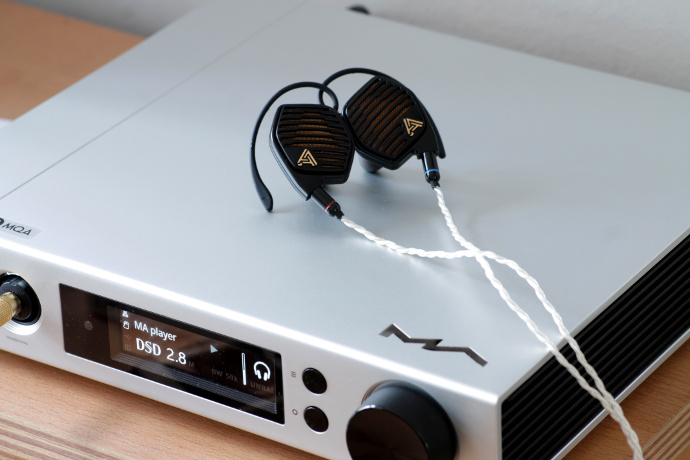
Matrix Audio Element M
Audeze – LCD-i4 (110dB/mW; 32 Ohms)
Even though the LCD-i4 has the highest sensitivity in amongst the headphones in this segment, I had to crank up the volume to -23.5dB to reach my listening levels. The LCD-i4 is one of the nicest discoveries of this year for me. Although it has been out for over two years already, I have only gotten to listen to it now. Better late than never.
With the LCD-i4 you get a fast sounding bass, that has big body and good weight. It goes deep into sub-bass with nice precision and speed. There is good texture, resolution and layering in the lows. Sub-bass has a lot of solid density, which gives the i4 a great drive and authority. It however doesn’t overthrow anything in the lows, but keeps things structured and controlled. Bass is energetic and exciting. Mids sound organic, slightly warmish and precise. There is good body and blood in every musician and instrument. The i4 has a superbly natural sound which is very hard to find at that level in an IEM.
The sound stage stretches wide and deep with an open feeling. You get extremely good resolution and micro detailing. The Element M fires in a ton of information, which the LCD-i4 reproduces without a sweat. Imaging is right about perfect, with sharply separated instruments. The LCD-i4 paints a beautiful picture right in front of you, where you can imagine the band and performers very well.
Treble is clear and clean, but not offensive or aggressive. You don’t get a super sharp or overly energized top end, but rather a slightly calmer and richer one, that keeps you safe from sibilance. The LCD-i4 is mighty fast and manages to really pull off a headphone-show with the Element M.
The final page gives you insight on Comparisons. Jump here!







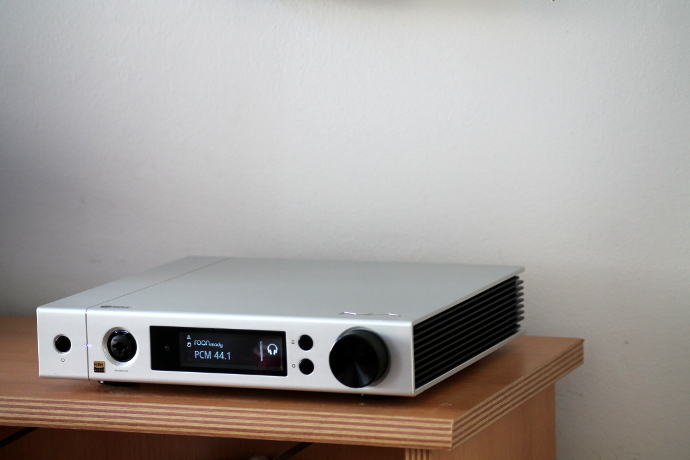
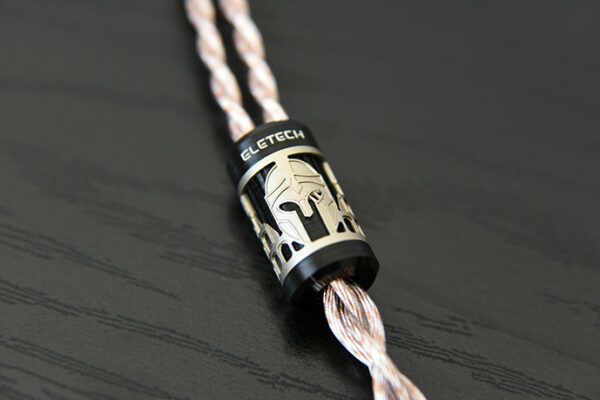
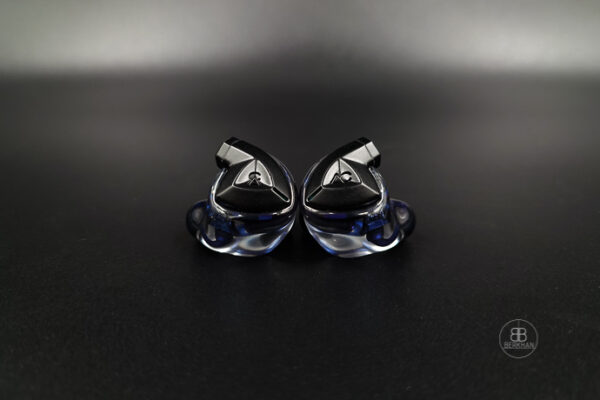
John
How does it compare to the Burson Conductor?
Linus
Hi John,
thanks for stopping by and leaving a comment.
I can’t speak for many of the Conductors, but I do have the C 3X at hand. It’s more neutral and less shiny in the treble in comparison. The Burson also puts more weight and body in the notes, which gives a fuller impression. The Element M on the other hand has nicer richness, which makes it sound more staturated.
Apart from that the two units also have very different features. While I appreciate that the Burson is fully balanced, it would’ve been nice to get an RCA in and output as well… The Matrix is more versatile in regards to digital inputs and analogue outputs.
Sound-wise I’ll get more into detail with the upcoming Conductor 3X review soon.
Hope that helps.
Cheers!
John
Linus, thanks for your reply. When you say saturated, are you referring to warmer, analogue type of sound? Looking forward to the 3X review as it and the Matrix are on the dem list.
Linus
Hi John,
not necessarily warmer, but sweeter and wetter sounding compared to a more neutral and dryer sounding C3X.
Hope that makes sense.
Cheers
John
It does. Thanks.
Edward
” The Element M goes straight up to our Best DAC/Amp combos and I have a feeling it will be there for a long while. ”
It is not there yet.